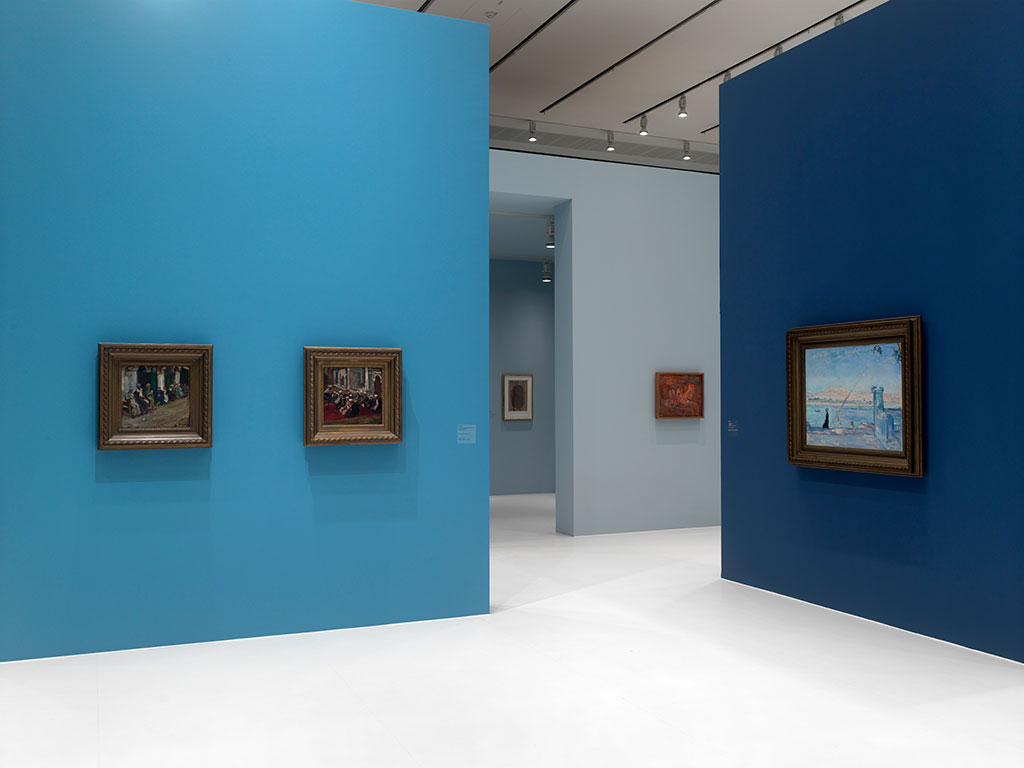Egypt, the Land of the Pharaohs, has fascinated humankind for millennia. In the wake of Napoleon’s campaign at the turn of the nineteenth century, the country along the Nile became a favored destination for educational and cultural tourism. Until today, the Orient retains its allure of strangeness and mystery. Its shimmering light and unique landscapes fired the imagination of many artists. Like other non-European or lost cultures, Egypt came to be seen as the quintessence of the primordial, and was associated with the search for an alternative to the increasingly industrialized societies of the north. Among travelers to Egypt were the Impressionist painter Max Slevogt (1868–1932) and Paul Klee (1879–1940), a leading representative of the artistic avant-garde. In the exhibition To Egypt! The Travels of Max Slevogt and Paul Klee, approximately 130 paintings, watercolors, and drawings – all produced in connection with their Egyptian travels – elucidate the upheavals that occurred during the transition from Impressionism to Classical Modernism.
This exhibition has received generous support in the form of high-quality loan works from museums in Germany and abroad, along with renowned private collections. Complementing the presentation of artworks are historic photographs and documents. During his Egyptian trip, Slevogt produced a singular cycle of powerfully colorful paintings. These works, now preserved in Dresden, are extraordinarily fragile, and are permitted to leave only in exceptional cases the museum The impressions Slevogt received in Egypt sparked a hitherto unprecedented coloristic and compositional virtuosity.
Assisted by attendants and equipped with a full panoply of painting materials, he worked on site to create cycles of paintings that are still regarded as highpoints of German Impressionism. Only during this trip did the anecdotal and clichéd traits of his previous work give way to a spontaneous and at the same time realistic rendering of the sites he visited. Not the historic ruins, the pyramids and temple remains, stood at the center of Slevogt’s interest, but instead the people, everyday life at the marketplaces, along with the endless desert landscape. Unlike Slevogt, Klee traveled to Egypt alone and with minimal luggage.
After visiting ancient Egyptian monuments and tombs, he admired in particular the fertile landscape and intensive agricultural activity along the Nile. Klee produced almost no work in Africa, instead reflected upon and transformed the visual stimuli he received there in a series of new works only after returning to his studio. In particular his striated compositions, which date from 1929, seem purely mathematical, as though derived from ancient Egyptian teachings. The bar forms and abstract symbols so characteristic of Klee’s late works seem to reflect impressions of Egyptian hieroglyphic writing. that houses them. Slevogt’s highly individual achievement provides a counterpoint to Paul Klee’s idiosyncratic and poetic pictorial universe: the selection of works by Klee range from the early drawings produced around 1900 to the striking late works of the 1930s.
This exhibition juxtaposes the works of a pair of artists who, although coexisting during the same period, exemplify highly divergent pictorial traditions and intellectual worlds. Not only did Slevogt and Klee experience Egypt differently, they processed their artistic perceptions in markedly contrasting ways. Slevogt journeyed to Egypt in spring of 1914, when the country was still under British colonial rule. His journey (which also took place during the German Imperial era), stood in the tradition of the Grand Tour typically undertaken by painters of the Orient. Fifteen years later, during the turn from 1928 to 1929, Paul Klee followed the same route from Alexandria via Cairo and Luxor to Aswan.
Now under altered political and social conditions, his journey took him to a country that had achieved independence in 1922. With the foundation of the Weimar Republic at the end of World War I, Germany too experienced a political reorientation. Both artists had been familiar with the culture of ancient Egypt through exhibitions held in Germany after major excavations such as those at Tell el-Amarna, where the celebrated Bust of Nefertiti was discovered in 1912. Slevogt’s image of Egypt was also stimulated by fantastical tales such as The Thousand and One Nights, which captivated him already as a child, and served as a continuous source of inspiration for paintings and illustrations. As early as the period around 1900, Klee had incorporated forms into his works that are Reminiscent of the pyramids and hieroglyphs. A trip to Tunisia in 1914 further fueled his interest in North Africa and the Orient.

